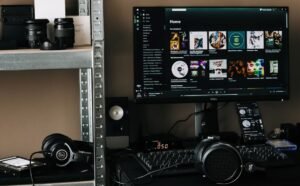Music You Can Use on YouTube
YouTube has become a popular platform for content creators to share their work and engage with a wide audience. Alongside the visuals, the right music can greatly enhance the impact and appeal of a video. In this article, we will explore the different options available for using music on YouTube and share some tips to navigate copyright issues.
Key Takeaways
- Exploring music options for YouTube videos is essential for creating engaging content.
- YouTube provides various ways to legally use music, including the YouTube Audio Library and commercial licenses.
- Copyright issues can arise when using copyrighted music without proper licensing or permission.
- Using royalty-free or Creative Commons-licensed music is a safer alternative.
- Proper attribution is important when using music created by others.
Using the YouTube Audio Library
In order to provide creators with access to a wide range of free music options, YouTube has introduced the YouTube Audio Library. This library consists of a collection of high-quality audio tracks that can be freely used in YouTube videos, without the need to obtain individual licenses.
**The YouTube Audio Library offers a diverse selection of music genres, including rock, hip hop, instrumental, and electronic.** Additionally, the library allows users to filter the available tracks based on mood, instrument, duration, and attribution requirements. *For example, creators can search for upbeat, guitar-driven music with a duration of 2 minutes or shorter, making it ideal for transition or background music.*
Commercially Licensed Music
While the YouTube Audio Library offers a wide range of free options, it may not always meet the specific needs of creators. In such cases, acquiring commercial licenses for music can be a viable option. These licenses grant creators the legal right to use copyrighted and popular music in their YouTube videos.
**Commercial licenses can be acquired directly from artists, record labels, or through music licensing platforms.** These licenses often come with specific terms and conditions related to the duration of usage and permitted platforms. *By obtaining a commercial license, creators can add popular songs and recognizable tunes to their videos, offering a familiar soundscape to their audiences.*
| Platform | Features | Pricing |
|---|---|---|
| Artlist | Curated music collection, unlimited downloads, perpetual rights, and commercial use. | $199/year |
| Epidemic Sound | Extensive music library, frequent updates, easy license management, and unlimited usage. | Starting from $15/month |
| PremiumBeat | High-quality music tracks, various genres, easy licensing, and synchronization for film and TV. | Varies |
Navigating Copyright Issues
Using copyrighted music without proper authorization can result in copyright claims or even the removal of your YouTube video. Therefore, it is important to be aware of copyright issues and understand how to navigate them effectively.
**Royalty-free music** is a common alternative for creators to avoid copyright claims. These are music tracks that can be used without paying any additional royalties or fees beyond the initial licensing cost. *By using royalty-free music, creators can enjoy peace of mind, knowing that their videos will not be flagged or taken down due to copyright violations.*
**Creative Commons-licensed music** is another option available for video creators. Creative Commons licenses allow artists to specify the permissions for their work, granting others the freedom to use their music with certain conditions. *By properly attributing the artist and following the specified licensing requirements, creators can use Creative Commons music without legal complications.*
Attribution and Crediting
When using music created by others, it is important to provide proper attribution and credit the original artist. This not only helps to respect the creators’ work but also ensures compliance with licensing agreements and copyright laws.
**Always include the following information in your video and description:** the title of the music track, the artist’s name, and a link to the original source. *Providing accurate and complete attribution helps build a positive relationship with artists and avoids any potential disputes over the use of their music.*
Conclusion
Exploring and incorporating music into your YouTube videos can greatly enhance the overall viewing experience and captivate your audience. YouTube offers various resources such as the YouTube Audio Library and commercial licensing options to ensure creators have access to a wide range of music choices. By understanding and adhering to copyright regulations, creators can confidently incorporate music into their videos while respecting the rights of artists. Happy music searching and creating!

Common Misconceptions
1. Artists don’t allow their music to be used on YouTube
One common misconception is that artists do not allow their music to be used on YouTube. While it is true that some artists may have restrictions on their music, many artists actually encourage their fans to use their music in their YouTube videos.
- Artists often provide licensing options for YouTube use.
- Some artists even offer their music for free to use on YouTube.
- Using music from lesser-known artists can help promote their work.
2. You need to ask permission for every song you use
Another common misconception is that you need to ask permission for every song you use in your YouTube videos. While it is advisable to check the copyright status of a song before using it, there are many resources available for finding music that is already cleared for use on YouTube.
- Websites like YouTube Audio Library provide a wide range of royalty-free music.
- Some music platforms offer a “YouTube-safe” filter to easily find music for video use.
- Using creative commons licensed music from platforms like SoundCloud and Jamendo is also a valid option.
3. Any type of music can be used without consequences
One misconception is that any type of music can be used without consequence. It’s important to remember that using copyrighted music without permission can lead to copyright strikes, demonetization, or even legal action. There are guidelines and rules in place that creators should follow to use music legally on YouTube.
- Understanding fair use and fair dealing exceptions is essential.
- More lenient usage policies may exist for certain genres of music, such as classical compositions.
- Attributing the music to the original artist and providing proper credits can help avoid problems.
4. Any music labeled as “royalty-free” is safe to use
Another misconception is that any music labeled as “royalty-free” is always safe to use on YouTube. While music labeled as royalty-free generally means that you don’t have to pay royalties for using the music, it doesn’t guarantee that there are no other usage restrictions or limitations.
- Review the licensing terms and conditions to understand the specific usage rights.
- Some royalty-free music may require attribution in the video description or credits.
- Certain royalty-free music libraries may have restrictions on commercial use or usage limits.
5. YouTube’s Content ID system detects all copyrighted music
Lastly, many people mistakenly believe that YouTube’s Content ID system detects all copyrighted music used in videos. While Content ID is a powerful tool, it is not foolproof and may miss some instances of copyrighted music in videos.
- Content ID may not detect music that has been altered or remixed.
- Some copyrighted music may not be registered with Content ID.
- Manually searching for music copyright information is still necessary for complete assurance.

The Popularity of Music Genres on YouTube
YouTube has become a platform for discovering and enjoying music across various genres. This table presents the top five music genres on YouTube, based on the number of views for their most popular videos.
| Genre | No. of Views (in billions) |
|---|---|
| Pop | 83.7 |
| Hip Hop | 58.2 |
| Rock | 42.5 |
| EDM | 37.9 |
| R&B | 29.6 |
The Most Subscribed Music Channels on YouTube
YouTube has seen the rise of numerous music channels with millions of subscribers. Here are the top five most subscribed music channels on YouTube:
| Channel Name | No. of Subscribers (in millions) |
|---|---|
| T-Series | 146 |
| Justin Bieber | 70.9 |
| Blackpink | 65.2 |
| Marshmello | 64.5 |
| Ariana Grande | 63.8 |
The Most Viewed Music Videos of All Time
The following table showcases the top five most viewed music videos on YouTube, capturing the attention of billions of viewers worldwide:
| Music Video | No. of Views (in billions) |
|---|---|
| “Baby Shark Dance” by Pinkfong | 12.5 |
| “Despacito” by Luis Fonsi ft. Daddy Yankee | 7.9 |
| “Shape of You” by Ed Sheeran | 5.4 |
| “See You Again” by Wiz Khalifa ft. Charlie Puth | 5.2 |
| “Gangnam Style” by Psy | 3.9 |
The Impact of Music Streaming on YouTube
Music streaming has revolutionized the way we consume music. This table highlights the significant increase in music streaming on YouTube over the past five years:
| Year | No. of Music Streams (in billions) |
|---|---|
| 2016 | 869 |
| 2017 | 1,283 |
| 2018 | 1,879 |
| 2019 | 2,564 |
| 2020 | 3,715 |
The Most Influential YouTube Music Artists
The YouTube platform has provided a launching pad for many talented musicians. Below are the names of five music artists who gained fame through YouTube:
| Artist | No. of Subscribers (in millions) |
|---|---|
| Post Malone | 29.8 |
| Dua Lipa | 25.6 |
| Juice WRLD | 24.9 |
| Shawn Mendes | 23.7 |
| Billie Eilish | 22.1 |
The Global Reach of YouTube Music
YouTube enables music to transcend boundaries and reach audiences worldwide. This table displays the top five countries with the highest number of music listeners on YouTube:
| Country | No. of Music Listeners (in millions) |
|---|---|
| United States | 167 |
| India | 145 |
| Brazil | 99 |
| Mexico | 79 |
| Indonesia | 66 |
Artists with the Highest Video Quality Production
Music videos have evolved into visually stunning productions. This table showcases five music artists who are known for their high-quality video productions:
| Artist | No. of Music Videos in 4K Resolution |
|---|---|
| Beyoncé | 27 |
| Taylor Swift | 23 |
| Bruno Mars | 19 |
| Kendrick Lamar | 16 |
| Lady Gaga | 14 |
The Growth of YouTube Music Subscriptions
Many users are opting for YouTube Music subscriptions to enjoy an ad-free listening experience. This table highlights the growth of YouTube Music subscriptions over the past three years:
| Year | No. of Subscribers (in millions) |
|---|---|
| 2018 | 10 |
| 2019 | 20 |
| 2020 | 30 |
YouTubers Turned Music Artists
Many popular YouTubers have successfully transitioned into music careers. Here are five notable YouTubers who became successful music artists:
| Artist | No. of Monthly Listeners (in millions) |
|---|---|
| Troye Sivan | 19.5 |
| Conan Gray | 14.8 |
| Dodie | 12.2 |
| KSI | 10.6 |
| Joji | 9.3 |
Music on YouTube has become a powerful force in the industry, with diverse genres and artists gaining popularity and reaching millions of viewers worldwide. From the most subscribed channels to the most viewed music videos, YouTube has undoubtedly reshaped the way we consume and appreciate music.
Frequently Asked Questions
Q: Can I use any music in my YouTube videos?
A: No, you cannot use any music. You must have the necessary rights or permissions to use the music in your videos in order to avoid copyright infringement.
Q: What is royalty-free music?
A: Royalty-free music refers to a type of music that can be used in videos, presentations, or other media projects without requiring the payment of ongoing royalties or licensing fees.
Q: Where can I find royalty-free music for my YouTube videos?
A: There are several websites and platforms that offer royalty-free music, such as Epidemic Sound, Artlist, and AudioJungle. You can browse their libraries and choose the music that suits your needs.
Q: Can I use popular songs in my YouTube videos?
A: Generally, using popular songs in your YouTube videos without permission from the rights holders is not allowed. You may receive copyright claims or your video may be taken down. It’s best to use royalty-free or licensed music.
Q: What is the difference between royalty-free and Creative Commons music?
A: Royalty-free music can be used without ongoing payments or royalties, while Creative Commons music is a type of music that has been shared by its creator under specific Creative Commons licenses, which may require attribution or have other restrictions.
Q: Can I use music from YouTube’s audio library?
A: Yes, YouTube provides a collection of music tracks and sound effects in their audio library that can be used in your videos. However, it’s important to review and respect the usage policies for each specific track.
Q: Do I need to credit the artist or composer when using royalty-free music?
A: It depends on the specific terms of the license. Some royalty-free music licenses may require attribution or credit to the artist or composer, while others may not have that requirement. Always check the license terms before using the music.
Q: Can I monetize YouTube videos that include royalty-free music?
A: Yes, in most cases, you can monetize YouTube videos that include royalty-free music, as long as you comply with the license terms. However, it’s important to review the specific licensing agreements to ensure your video remains compliant.
Q: Are there restrictions on using music in YouTube live streams?
A: Yes, the same rules and restrictions apply to using music in YouTube live streams. It’s crucial to have the necessary rights or permissions to use the music to avoid any issues during your live stream or potential copyright claims afterward.
Q: What should I do if my YouTube video gets a copyright claim due to music usage?
A: If you receive a copyright claim related to music in your YouTube video, you can either remove the music, replace it with royalty-free or licensed music, or dispute the claim if you believe you have the necessary rights or permissions to use the music.




